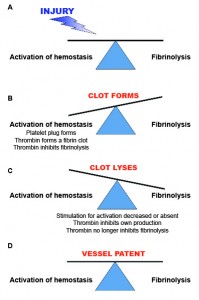A: Hemostasis is activated upon blood vessel injury.
B: This swings the pendulum in favor of procoagulant forces. Exposure of procoagulant extracellular matrix proteins and tissue factor on fibroblasts initiates platelet plug formation and thrombin generation, respectively. Thrombin forms the fibrin clot, which is enmeshed with the platelet plug. At the same time, thrombin (by activating thrombin-activatable fibrinolytic inhibitor) and polyphosphates (released from dense granules in platelets) inhibit fibrinolysis , preventing clot breakdown.
C: Once the clot forms and the vessel heals, the stimulus for thrombin generation decreases, thrombin begins to inhibit its own production (by binding to thrombomodulin, which activates Protein C; activated Protein C with free Protein S as a cofactor inhibits the cofactor activity of the “intrinsic tenase” and “prothrombinase” cofactors, FVIIIa and FVa, respectively) and no longer inhibits fibrinolysis (decreased thrombin-activatable fibrinolytic inhibitor, the thrombomodulin-thrombin complex also suppresses plasminogen activator inhibitor, allowing tissue plasminogen activator to convert plasminogen to plasmin), swinging the pendulum in favor of fibrinolysis.
D: Lysis of the clot restores vessel patency and the original status quo.
“Reproduced and modified with permission from the BSAVA Manual of Canine and Feline Clinical Pathology, 3rd edition.”

